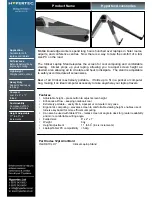
Software Functional Overview 3-3
Controller Chip
Description
Keyboard
Controller
Supports <Fn> hot keys, two Win95 hot keys, built-in Glidepad
and external PS/2 mouse/keyboard
PCMCIA
Complies with PCMCIA 2.1 specification
CD-ROM
Supports boot from CD-ROM
Port Replicator
I/O port replicator duplicates the following ports:
Video port
Printer port
COM1 port
PS/2 Mouse & Standard Keyboard port
USB Port
DC-IN Jack
Power
Management
Support
The Power Management Unit complies with APM 1.2 specification
and supports the following power state:
Full-On Mode
Doze Mode (This mode is transparent to user)
Stand-By (POS) Mode
Suspend to RAM (STR) Mode
Suspend to Disk (STD) Mode
Soft-Off Mode (SOff)
Subsystem Software Functions
This section provides an introduction to the software functions of the notebook
subsystems and related functions.
Key Chipset Summary
Following are the main chipsets used in the notebook.
Key Chipsets
Controller Chip
Vendor
Description
Processor
INTEL
PENTIUM-II Intel Mobile Module (IMM)
233/266/300 MHz
Tillamook Intel Mobile Module (IMM)
233/266 MHz
Core Logic
INTEL
443BX - 82443BX & PIIX4E(82371EB)
Video Controller
NeoMagic
NM2160 (NMG4)
PCMCIA Controller
TI
PCI 1221
Supplier I/O Controller
SMC
FDC37N769
Audio Chip
ESS
ES1968S (Maestro-2)
Audio Codec
Wolfson
WM9701
Audio Amplifier
TI
TPA0102
Keyboard Controller
Mitsubishi
M38867
PMU Controller
MicroChip
PIC16C62 (SSOP)
Gas Gauge IC
Benchmarq
BQ2092
















































